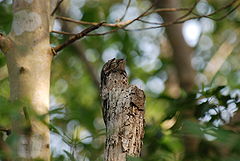Nyctibius
Wygląd
| Nyctibius[1] | |||
| Vieillot, 1816[2] | |||
 Przedstawiciel rodzaju – nocolot szary (N. griseus) | |||
| Systematyka | |||
| Domena | |||
|---|---|---|---|
| Królestwo | |||
| Typ | |||
| Podtyp | |||
| Gromada | |||
| Podgromada | |||
| Infragromada | |||
| Rząd | |||
| Rodzina | |||
| Rodzaj |
Nyctibius | ||
| Typ nomenklatoryczny | |||
|
Caprimulgus grandis J.F. Gmelin, 1789 | |||
| Synonimy | |||
| |||
| Rodzaje | |||
| |||
| Zasięg występowania | |||

| |||
Nyctibius – rodzaj ptaków z rodziny nocolotów (Nyctibiidae).
Zasięg występowania
[edytuj | edytuj kod]Rodzaj obejmuje owadożerne ptaki średniej wielkości, prowadzące nocny tryb życia, występujące w Ameryce Południowej i Środkowej oraz w Meksyku[5][6].
Charakterystyka
[edytuj | edytuj kod]Długość ciała 24–58 cm; masa ciała 77–620 g[5].
Systematyka
[edytuj | edytuj kod]Etymologia
[edytuj | edytuj kod]- Ibijus: na podstawie „Ibijau” Raya z 1713 i „Ibiyaú” Azary z 1805[7]. Nomen nudum.
- Nyctibius: gr. νυκτιβιος nuktibios „nocne jedzenie”, od νυξ nux, νυκτος nuktos „noc”; βιοω bioō „żyć”[8].
- Selochusa: fikcyjny ptak, na podstawie „Engoulevent à Queue Fourchue” Levaillanta z 1799 (ryc. 47)[9].
Podział systematyczny
[edytuj | edytuj kod]Do rodzaju należą następujące gatunki[10]:
- Nyctibius grandis (J.F. Gmelin, 1789) – nocolot wielki
- Nyctibius aethereus (zu Wied-Neuwied, 1820) – nocolot wielkosterny
- Nyctibius maculosus Ridgway, 1912 – nocolot andyjski
- Nyctibius leucopterus (zu Wied-Neuwied, 1821) – nocolot białoskrzydły
- Nyctibius jamaicensis (J.F. Gmelin, 1789) – nocolot północny
- Nyctibius griseus (J.F. Gmelin, 1789) – nocolot szary
Kladogram
[edytuj | edytuj kod]Kladogram Nyctibius na podstawie Taxonomy in Flux Checklist[11]:
| |||||||||||||||||||||||||||||||||||||
Przypisy
[edytuj | edytuj kod]- ↑ Nyctibius, [w:] Integrated Taxonomic Information System (ang.).
- ↑ L.J.P. Vieillot: Analyse d’une nouvelle ornithologie élémentaire. Paris: Deteville, libraire, rue Hautefeuille, 1817, s. 38. (fr.).
- ↑ C.S. Rafinesque: Analyse de la nature, or, Tableau de l’univers et des corps organisés. Palerme: Aux dépens de l’auteur, 1815, s. 69. (fr.).
- ↑ G.R. Gray: A list of the genera of birds: with their synonyma an indication of the typical species of each genus. Wyd. 2. London: R. and J.E. Taylor, 1841, s. 9. (ang.).
- ↑ a b D.W. Winkler, S.M. Billerman & I.J. Lovette: Potoos (Nyctibiidae), version 1.0. W: S.M. Billerman, B.K. Keeney, P.G. Rodewald & T.S. Schulenberg (red. red.): Birds of the World. Ithaca, NY: Cornell Lab of Ornithology, 2021. DOI: 10.2173/bow.nyctib1.01. [dostęp 2021-03-30]. (ang.).

- ↑ Potoos (Nyctibiidae). IBC: The Internet Bird Collection. [zarchiwizowane z tego adresu (2016-04-11)]. (ang.).
- ↑ Ibijus, [w:] The Key to Scientific Names, J.A. Jobling (red.), [w:] Birds of the World, S.M. Billerman et al. (red.), Cornell Lab of Ornithology, Ithaca [dostęp 2022-01-27] (ang.).
- ↑ Nyctibius, [w:] The Key to Scientific Names, J.A. Jobling (red.), [w:] Birds of the World, S.M. Billerman et al. (red.), Cornell Lab of Ornithology, Ithaca [dostęp 2022-01-27] (ang.).
- ↑ Selochusa, [w:] The Key to Scientific Names, J.A. Jobling (red.), [w:] Birds of the World, S.M. Billerman et al. (red.), Cornell Lab of Ornithology, Ithaca [dostęp 2022-01-27] (ang.).
- ↑ Systematyka i nazwy polskie za: P. Mielczarek & M. Kuziemko: Rodzina: Nyctibiidae Chenu & des Murs, 1851 – nocoloty - Potoos (wersja: 2022-08-11). [w:] Kompletna lista ptaków świata [on-line]. Instytut Nauk o Środowisku Uniwersytetu Jagiellońskiego. [dostęp 2022-10-09].
- ↑ J. Boyd III: Nyctibiidae: Potoos. [w:] Taxonomy in Flux Checklist 3.08 [on-line]. John Boyd’s Home Page. [dostęp 2022-09-15]. (ang.).